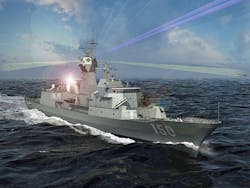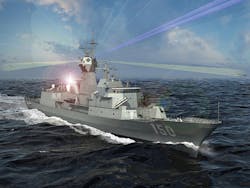Raytheon developing ship antennas to handle radar, radio, and EW simultaneously
ARLINGTON, Va.— U.S. Navy shipboard electronics experts are pushing forward with a project to design dynamic multi-mission radar antennas able to carry out functions like surveillance, communications and electronic warfare (EW) simultaneously.
Officials of the Office of Naval Research (ONR) in Arlington, Va., announced a $9.5 million order to the Raytheon Co. Integrated Defense Systems segment in Tewksbury, Mass., for the Flexible Distributed Array Radar (FlexDAR) effort.
In this order, Raytheon will demonstrate how combining every-element digital beamforming, network coordination, and precise time synchronization can enable multiple-input and multiple-output (MIMO) operation to improve shipboard target detection, tracking, and electronic protection.
The U.S. Navy is asking Raytheon to develop dynamic multi-mission radar antennas for simultaneous surveillance, communications and electronic warfare.
MIMO uses several transmit and receive antennas to multiply the capacity of an RF link like radar by exploiting multipath propagation. It sends and receives more than one data signal simultaneously over the same radio channel.
MIMO is one way for systems designers to reduce the number of RF transmit and receive antennas on large platforms like surface warships. Placing many antennas in a relatively small space can cause cross RF interference.
FlexDAR is part of the Navy’s Integrated Topside (InTop) program to develop a scalable family of EW, radar, signals intelligence (SIGINT) and communications systems for several classes of Navy surface ships and submarines.
In 2012 ONR researchers asked 18 InTop contractors to work on developing a scalable family of radar antennas as part of the InTop FlexDAR project. The InTop program began in 2009.
The InTop program seeks to dominate the RF spectrum and create affordable, scalable antennas and antenna subsystems on Navy surface ships and submarines not only for radar, but also for EW and RF communications systems.
A growing number of antennas aboard today’s surface combatants has led to problems with electro-magnetic interference (EMI), radar cross sections, and the overall performance of shipboard electronic warfare, radar, and communications systems.
In addition to Raytheon, the InTop contractors are:
- ATK Space Systems in Dayton, Ohio;
- Argon ST in Fairfax, Va.;
- BAE Systems in Nashua, N.H.;
- Ball Aerospace & Technologies Corp. in Broomfield, Colo.;
- Boeing Co. in Seattle;
- Cobham Defense Systems in Landsdale, Pa.;
- Colorado Engineering Inc. in Colorado Springs, Colo.;
- DRS Signal Solutions Inc. in Germantown, Md.;
- FTL Systems Inc. in Rochester, Minn.;
- General Dynamics Mission Systems in Fairfax, Va.;
- Harris Corp. Radar Systems in Van Nuys and Thousand Oaks, Calif.;
- HYPRES Inc. in Elmsford, N.Y.;
- Lockheed Martin Corp. in Moorestown, N.J.;
- Northrop Grumman Corp. in Baltimore;
- S2 Corp. in Bozeman, Mont.; and
- Southwest Research Institute in San Antonio, Texas.
The FlexDAR project is developing technology to enhance the capabilities of future radar sensors including software-defined digital re-configurability at the foundational level, Raytheon officials say.
The program demonstrates radar and radar-to-radar communications for bi-static radar exchange and control, which increases detection and firm-track range and improves electronic protection.
Raytheon has designed an InTop FlexDAR radar front-end, and built two identical multi-function array antennas for ONR’s Chesapeake Bay Detachment near Chesapeake Beach, Md., to demonstrate network-linked, distributed sensors and explore next-generation radar capabilities.
On this order Raytheon will do the work in Tewksbury, Mass., and should be finished by February 2019.
For more information contact Raytheon Integrated Defense Systems online at www.raytheon.com, or the Office of Naval Research at www.onr.navy.mil.

